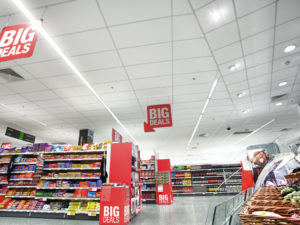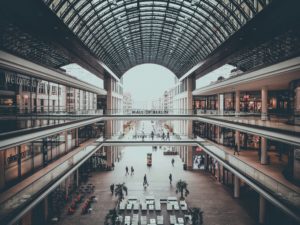
Even before the recent spike in prices, energy costs were one of the biggest costs for retailers. As a result, retailing is just one of the many industries that are rapidly adopting energy-efficient lighting solutions to keep rising overheads in check. A recent study by E.ON revealed that 46% of retailers had moved to LED lighting within the previous 12 months.

A 15-year-old system uses five times more energy than a new system. When you consider that 95% of the environmental impact caused by lighting comes from energy consumption, you can understand the importance of reducing this by up to 80% with modern LED luminaires and control systems. With modern LED lighting products, it is now possible to achieve up to 200 lumens per watt at source and with modern optical materials, you can still deliver impressive energy and, in turn, carbon savings.
Another benefit of LED lighting solutions is the extra level of control that they offer you. With wireless and Bluetooth technology and the Internet of Things, you can set up an automatic programme to subtly change throughout the day and create different moods. You can also change the lighting in any particular area of the store at the merest touch of a button.
LED lighting has a significantly lower operating temperature than traditional lighting solutions which makes it a much better option for food display units, as it doesn’t generate heat that will spoil the produce. Due to the high lumen output per watt, LEDs are able to transform an impressive 70% of their energy into light. This makes them considerably more efficient (and food-friendly) than traditional light sources that waste around 90% of their energy by turning it into heat.

Right at the vanguard of this environmentally-friendly lighting revolution, Sainsbury’s are entering the next step of a multi-phase programme to upgrade their entire estate, including the replacement of fluorescent technology with LED. Sainsbury has more than 600 supermarkets in the UK and their environmental ambitions match the vast size of the operation.
Most of Sainsbury’s real estate, including stores and distribution centres have already made the switch to LED. The scale of this operation is enormous, with the retailer installing a quarter of a million LED fixtures across 450 stores. Upgrading their lighting alone is expected to cut Sainsbury’s total energy use by 58%.
The considerable ongoing financial commitment to this programme means that Sainsbury’s are probably the leading UK retail brand in this area. This is great news for their business, as well as the planet. Sainsbury’s are already using 11.6% less electricity than they did in 2005, despite growing operations by 54%.
Marks & Spencer (M&S) are thinking along the same lines as Sainsbury’s, as they work towards introducing LED lighting to every aspect of their business by 2025. As well as changing the light fittings, M&S have seen the benefits of changing the way that their people think and behave. The company has prioritised motivating staff to adopt more energy-efficient practices by linking individual KPIs to energy targets, and this is already starting to have a significant impact on energy consumption.
M&S estimate that around a quarter of the 36% energy savings they have recently experienced can be put down to good communications and strong guidance given to employees. M&S have seen a £625m net benefit from their sustainability strategy, with £30m generated from energy savings last year alone.
Phi Lighting helps forward-thinking companies like Sainsbury’s and M&S achieve their ambitious targets. There are many different aspects to sustainability for retailers and the more efficient the lighting solutions, the less work needs to be done in other areas to reach carbon neutrality.
Phi’s vision for a sustainable future for retailers covers three main areas. We will continue to work closely with architects and client design teams to maximise the use of daylight in-store designs, wherever possible.

We will also take advantage of new smart fittings incorporating the Internet of Things. These enable data collection and the development of data-led services that ensure installations will run more efficiently.
We’re already starting to cut down on single-use materials. We are now also measuring the percentage of materials in a fitting that can be reused and companies are working harder to produce modular, reusable products to make them last longer. But, at the same time, the rapid improvement of LED technologies means that serviceable luminaires are being disposed of when in fact they could be refurbished with new light sources, to prevent housings and other components from being wasted. There’s still more we can do in support of the mantra: Maintain – upcycle – recycle.
Finally, we are committing to invest more time and energy in researching new more sustainable manufacturing techniques and processes. These continue to evolve and we are always looking for fresh opportunities to increase the use of recycled material in our product design and development.
If you’d like to discuss how Phi Lighting could help your business, please get in touch.
I can rely on Phi being proactive on issues arising.
Relationships & Empathy
Phi understands us, our scope and our limitations.
Relationships & Empathy
Phi delivers a good solution, which is more than just a product. Their service is good, they talk through schemes with us and there is more to it than just a catalogue.
Technical Skills
The main asset of Phi is people and the high level of technical backup they provide. For example with their competitors I meet a salesman and not a technical salesman. This difference is crucial.
Technical Skills
Good quality products at a reasonable price.
Price
Phi is not the cheapest supplier but they offer quality architectural fittings.
Price
Phi’s personal service is appreciated and differentiates them.
Service
During completed projects, we have been happy with the performance and communication from Phi. I can rely on Phi being proactive on issues arising.
Service
I see Phi for architectural led office foyers, reception areas, bespoke spaces in office blocks and good architectural lighting for commercial developments
Spaces
Appropriate for the commercial sector in particular and other places where there is a modern style requirement as befits their current product range.
Spaces
Phi is most suited to commercial offices, associated rooms and educational buildings.
Spaces
Phi delivers a good solution, which is more than just a product.
Perception & Image
We are project focused; there are lots of people in the industry but it is questionable whether they want to help and support properly. Why change to someone who may let you down, you stick with the best.
Perception & Image
Phi is not mainstream but a specialist niche architectural supplier who is a little bit different.
Perception & Image
Phi offer support, which sets them apart.
Perception & Image
Phi is a strong quality architectural supplier, giving good advice where we are lacking.
Perception & Image
Phi offer a great level of experience, supply, service and back up.
Perception & Image
I can rely on Phi being proactive on issues arising.
Relationships & Empathy
Phi understands us, our scope and our limitations.
Relationships & Empathy
Phi delivers a good solution, which is more than just a product. Their service is good, they talk through schemes with us and there is more to it than just a catalogue.
Technical Skills
The main asset of Phi is people and the high level of technical backup they provide. For example with their competitors I meet a salesman and not a technical salesman. This difference is crucial.
Technical Skills
Good quality products at a reasonable price.
Price
Phi is not the cheapest supplier but they offer quality architectural fittings.
Price
Phi’s personal service is appreciated and differentiates them.
Service
During completed projects, we have been happy with the performance and communication from Phi. I can rely on Phi being proactive on issues arising.
Service
I see Phi for architectural led office foyers, reception areas, bespoke spaces in office blocks and good architectural lighting for commercial developments
Spaces
Appropriate for the commercial sector in particular and other places where there is a modern style requirement as befits their current product range.
Spaces
Phi is most suited to commercial offices, associated rooms and educational buildings.
Spaces
Phi delivers a good solution, which is more than just a product.
Perception & Image
We are project focused; there are lots of people in the industry but it is questionable whether they want to help and support properly. Why change to someone who may let you down, you stick with the best.
Perception & Image
Phi is not mainstream but a specialist niche architectural supplier who is a little bit different.
Perception & Image
Phi offer support, which sets them apart.
Perception & Image
Phi is a strong quality architectural supplier, giving good advice where we are lacking.
Perception & Image
Phi offer a great level of experience, supply, service and back up.
Perception & Image
Phi Lighting Ltd
Unit 9, Brook Business Park, Brookhampton Lane, Kineton, CV35 0JA
Phone: +44 (0)1926 640 366Fax: +44 (0)1926 641 747Email: quotes@phi-lighting.com
Phone: +44 (0)203 875 6484
